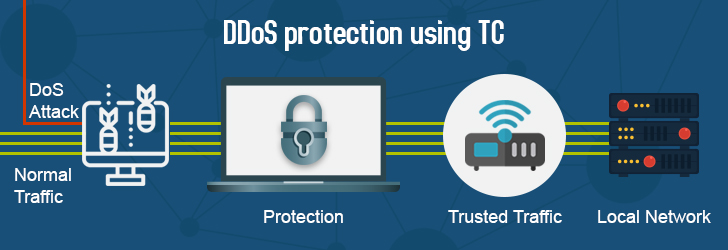

The two methods described below are extracted from the lartc howto. It is included here to provide a complete reference. For latest updates, please view source document.
From Alexey's iproute documentation, adapted to netfilter and with more plausible paths. If you use this, take care to adjust the numbers to reasonable values for your system.
If you want to protect an entire network, skip this script, which is best suited for a single host.
It appears that you need the very latest version of the iproute2 tools to get this to work with 2.4.0.
#! /bin/sh -x # # sample script on using the ingress capabilities # this script shows how one can rate limit incoming SYNs # Useful for TCP-SYN attack protection. You can use # IPchains to have more powerful additions to the SYN (eg # in addition the subnet) # #path to various utilities; #change to reflect yours. # TC=/sbin/tc IP=/sbin/ip IPTABLES=/sbin/iptables INDEV=eth2 # # tag all incoming SYN packets through $INDEV as mark value 1 ############################################################ $iptables -A PREROUTING -i $INDEV -t mangle -p tcp --syn \ -j MARK --set-mark 1 ############################################################ # # install the ingress qdisc on the ingress interface ############################################################ $TC qdisc add dev $INDEV handle ffff: ingress ############################################################ # # # SYN packets are 40 bytes (320 bits) so three SYNs equals # 960 bits (approximately 1kbit); so we rate limit below # the incoming SYNs to 3/sec (not very useful really; but #serves to show the point - JHS ############################################################ $TC filter add dev $INDEV parent ffff: protocol ip prio 50 handle 1 fw \ police rate 1kbit burst 40 mtu 9k drop flowid :1 ############################################################ # echo "---- qdisc parameters Ingress ----------" $TC qdisc ls dev $INDEV echo "---- Class parameters Ingress ----------" $TC class ls dev $INDEV echo "---- filter parameters Ingress ----------" $TC filter ls dev $INDEV parent ffff: #deleting the ingress qdisc #$TC qdisc del $INDEV ingress
Recently, distributed denial of service attacks have become a major nuisance on the Internet. By properly filtering and rate limiting your network, you can both prevent becoming a casualty or the cause of these attacks.
You should filter your networks so that you do not allow non-local IP source addressed packets to leave your network. This stops people from anonymously sending junk to the Internet.
Rate limiting goes much as shown earlier. To refresh your memory, our ASCIIgram again:
[The Internet] ------ [Linux router] --- [Office+ISP]
eth1 eth0
We first set up the prerequisite parts:
# tc qdisc add dev eth0 root handle 10: cbq bandwidth 10Mbit avpkt 1000 # tc class add dev eth0 parent 10:0 classid 10:1 cbq bandwidth 10Mbit rate \ 10Mbit allot 1514 prio 5 maxburst 20 avpkt 1000
If you have 100Mbit, or more, interfaces, adjust these numbers. Now you need to determine how much ICMP traffic you want to allow. You can perform measurements with tcpdump, by having it write to a file for a while, and seeing how much ICMP passes your network. Do not forget to raise the snapshot length!
If measurement is impractical, you might want to choose 5% of your available bandwidth. Let's set up our class:
# tc class add dev eth0 parent 10:1 classid 10:100 cbq bandwidth 10Mbit rate \ 100Kbit allot 1514 weight 800Kbit prio 5 maxburst 20 avpkt 250 \ bounded
This limits at 100Kbit. Now we need a filter to assign ICMP traffic to this class:
# tc filter add dev eth0 parent 10:0 protocol ip prio 100 u32 match ip protocol 1 0xFF flowid 10:100